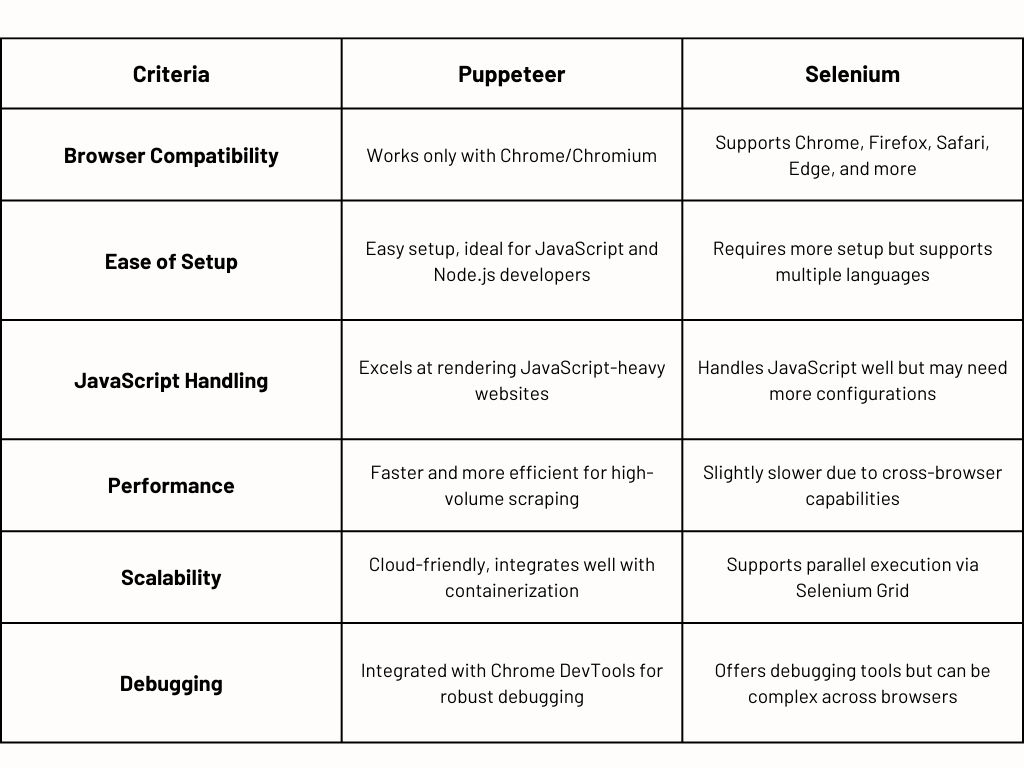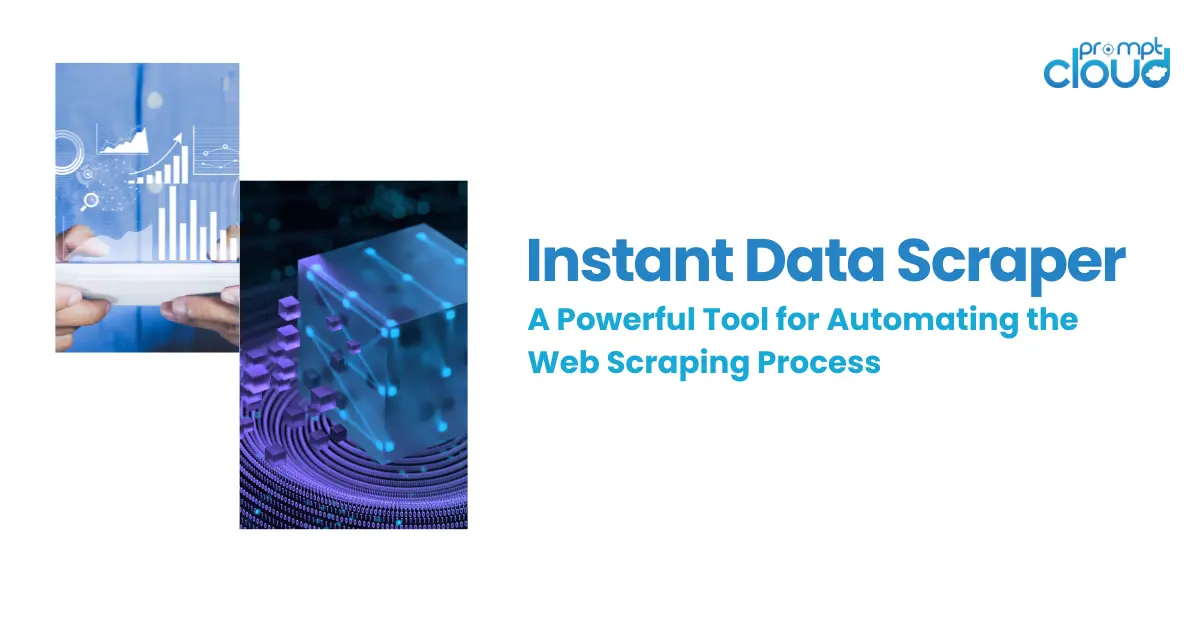
When it comes to extracting valuable data from websites, having the right tools is crucial. Two of the most popular options for automated, browser-based web scraping are Puppeteer and Selenium. Both are powerful, widely used, and capable of handling complex scraping tasks, but choosing between them can be challenging. In this guide, we’ll break down the strengths, limitations, and key differences of Puppeteer vs. Selenium web scraping to help you decide which tool best fits your needs.
What Are Puppeteer and Selenium?
Puppeteer and Selenium are both frameworks designed to interact with web browsers for automated tasks, making them ideal for web scraping. Here’s a brief introduction:
What is Puppeteer?
Puppeteer is a Node.js library that provides a high-level API to control headless Chrome or Chromium browsers. It’s built by the Google Chrome team, which means it’s tailored for Chrome automation, making it highly effective for scraping data from modern, JavaScript-heavy websites.
What is Selenium?
Selenium is a widely used, open-source framework that allows you to automate web browsers. It supports multiple programming languages, including Python, Java, C#, and JavaScript, and can control various browsers like Chrome, Firefox, Safari, and Edge. This versatility makes it one of the most popular choices for Selenium web scraping.
Now, let’s dive deeper into how these tools compare in terms of web scraping capabilities.
Puppeteer vs. Selenium: Key Differences You Need to Know

1. Browser Compatibility
- Puppeteer:
Puppeteer is designed to work with headless (or full) versions of Chrome and Chromium, making it highly efficient for scraping websites that are optimized for Chrome. However, it does not natively support other browsers, limiting its flexibility. - Selenium:
Selenium offers broader browser compatibility, working seamlessly with Chrome, Firefox, Safari, Edge, and more. If your scraping tasks require testing across different browsers, Selenium web scraping may be the better choice.
If you need cross-browser compatibility, Selenium is more versatile. If your focus is Chrome-specific scraping, Puppeteer is better optimized.
2. Ease of Setup and Use
- Puppeteer:
Puppeteer has a straightforward setup process, especially for those familiar with JavaScript and Node.js. Its API is intuitive, making it easy to set up headless Chrome scraping. With fewer configurations needed, it’s a faster option for beginners or small-scale projects. - Selenium:
Selenium’s setup can be more complex due to its support for multiple programming languages and browsers. While it offers greater flexibility, it requires more initial configuration. That said, once you’re familiar with its structure, Selenium web scraping becomes more manageable for large-scale, diverse tasks.
Puppeteer is simpler to set up, while Selenium offers more configuration options, making it more suitable for complex projects.
3. Handling JavaScript and Dynamic Content
- Puppeteer:
Puppeteer excels at rendering and interacting with JavaScript-heavy websites. It can handle dynamic content, single-page applications (SPAs), and AJAX-based sites efficiently. With Puppeteer, you can easily wait for elements to load, navigate through interactive components, and extract data without issues. - Selenium:
Selenium also supports dynamic content scraping, but it can be slower and less efficient than Puppeteer when handling heavy JavaScript websites. While Selenium web scraping is capable of managing dynamic elements, it may require additional configurations and workarounds to ensure the successful extraction of data.
Puppeteer is generally more efficient for JavaScript-heavy sites, while Selenium can handle dynamic content but may require more adjustments.
4. Performance and Speed
- Puppeteer:
Puppeteer operates directly with headless Chrome, making it faster and more lightweight for data extraction. It minimizes browser overhead, allowing for quicker page loads and faster data collection, making it ideal for speed-sensitive scraping tasks. - Selenium:
Selenium’s performance can vary depending on the browser used and the programming language. While it works well for Selenium web scraping, it tends to be slower than Puppeteer, especially when handling large-scale scraping tasks or processing heavy JavaScript.
Puppeteer is faster and more efficient, especially for high-volume scraping tasks, while Selenium may experience slower performance due to its cross-browser nature.
5. Error Handling and Debugging
- Puppeteer:
Puppeteer offers a robust debugging environment with built-in features like screenshots, PDF generation, and browser tracing. This makes it easier to identify and resolve issues during scraping. - Selenium:
Selenium also has good debugging tools, but due to its broader support for various browsers and languages, the debugging process can be more complex and time-consuming. It may require additional tools or configurations, making Selenium web scraping a bit more challenging for troubleshooting.
Both tools offer solid debugging capabilities, but Puppeteer is often considered more intuitive due to its seamless integration with Chrome Developer Tools.
6. Scalability and Cloud Integration
- Puppeteer:
Puppeteer’s lightweight nature makes it easier to integrate with cloud-based environments, offering smooth scalability. It works well with containerization tools like Docker, making it an excellent choice for large-scale projects that require cloud deployment. - Selenium:
Selenium is built for scalability and supports grid-based parallel execution, making it suitable for handling large-scale scraping projects. While it may require additional configurations to achieve cloud-based scalability, Selenium web scraping can effectively handle distributed scraping tasks.
Both Puppeteer and Selenium can scale effectively, but Puppeteer offers easier cloud integration, while Selenium’s grid system provides better parallel execution capabilities.
When Is Puppeteer the Right Choice for Web Scraping?
Puppeteer is ideal for scenarios where:
- You need to scrape JavaScript-heavy, Chrome-optimized websites.
- Speed and efficiency are priorities, especially for high-volume data extraction.
- You are primarily using Node.js and prefer a more streamlined setup.
- You require detailed browser control, debugging, and automation features specific to Chrome or Chromium.
When Is Selenium Your Best Bet for Web Scraping?
Selenium is better suited for situations where:
- You need to scrape data from different browsers or require cross-browser testing.
- You are using multiple programming languages and want more flexibility.
- Your scraping projects involve large-scale, distributed scraping tasks that require parallel execution.
- You need to perform Selenium web scraping across a variety of environments or integrate with existing frameworks.
When to Use Puppeteer vs. Selenium: Real-World Scenarios
1. E-commerce Price Monitoring
Both Puppeteer and Selenium web scraping can be used to monitor product prices, discounts, and availability across multiple e-commerce websites. Puppeteer offers speed, while Selenium offers broader browser compatibility, making it useful for testing various layouts.
2. Market Research and Data Collection
Gathering data from review sites, forums, and social media platforms is seamless with either tool. Puppeteer excels with JavaScript-heavy sites, while Selenium web scraping is better for cross-browser data collection.
3. Competitor Analysis
Both Puppeteer and Selenium web scraping are excellent for tracking competitor websites, product launches, and marketing strategies. Puppeteer’s faster rendering can help in extracting high-volume data quickly, while Selenium’s grid system supports broader data collection.
Best Practices for Successful Puppeteer and Selenium Web Scraping
- Use Rotating Proxies:
For both Puppeteer and Selenium web scraping, implementing rotating proxies can help prevent IP bans and ensure smoother data extraction. - Implement User-Agent Rotation:
Vary user-agent strings to mimic human browsing behavior, reducing the chances of getting blocked by target websites. - Handle Dynamic Elements Efficiently:
Both tools can interact with dynamic elements, but ensure you set appropriate wait times and handle AJAX requests properly to capture all required data. - Optimize for Performance:
Keep scripts optimized by using headless modes, reducing unnecessary browser interactions, and managing request rates effectively. - Ensure Compliance:
Always adhere to legal and ethical guidelines when scraping data, focusing on publicly available information and respecting website terms of service.
Conclusion
Deciding between Puppeteer and Selenium depends on your specific web scraping requirements. Puppeteer is best suited for speed and handling JavaScript-heavy websites, while Selenium web scraping offers broader flexibility across browsers and programming languages. Consider your project needs, technical expertise, and scalability requirements before making a choice. For custom web scraping services, get in touch or reach out to us at sales@promptcloud.com



















